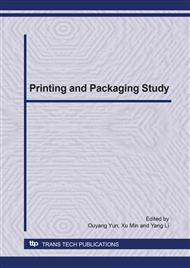p.215
p.219
p.223
p.227
p.231
p.235
p.239
p.243
p.247
Development and Comparison of Models for Predicting Printing Quality in Flexographic Printing
Abstract:
The effects of seven key technological properties(ink viscosity, anilox screen, type of doctor blade, plate shore hardness, plate relief depth, type of mounting tape and printing speed) in flexographic printing on printing quality properties(printing density, print contrast and run lengths) were investigated. And the best interactions were analyzed by orthogonal design of seven factors and two levels experiments. Predictive models were built by linear multiple regression analysis(MRA) and BP(Back Propagation) neural network respectively. A comparison of accuracy for models were discussed by a brief statistical analysis of their predictive errors. Results indicated that the most important factor influencing print density, print contrast and run length was type of doctor blade, plate relief depth and print speed respectively. The model of BP neural network provided higher prediction than that use of linear MRA. However, the linear MRA model was convenient to be used in production.
Info:
Periodical:
Pages:
231-234
Citation:
Online since:
December 2010
Authors:
Price:
Сopyright:
© 2011 Trans Tech Publications Ltd. All Rights Reserved
Share:
Citation:


